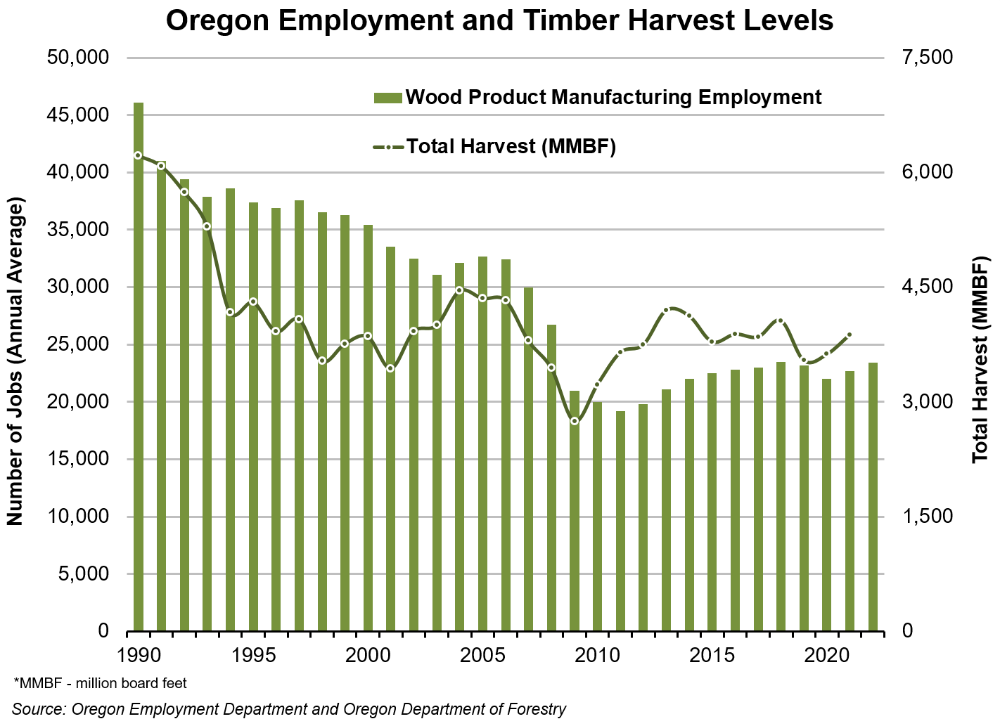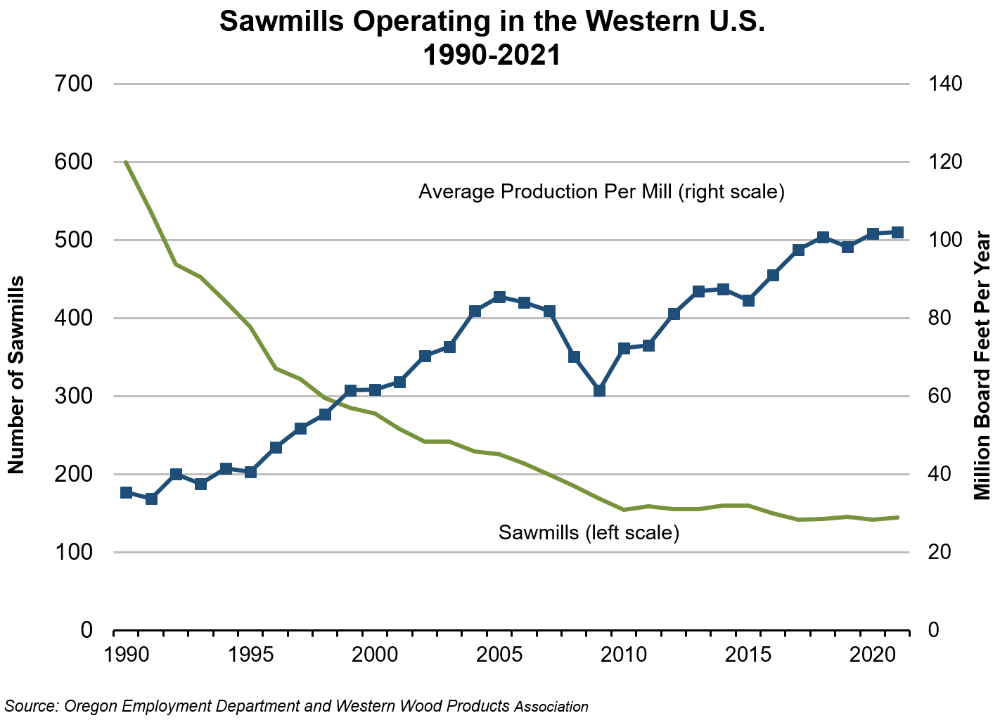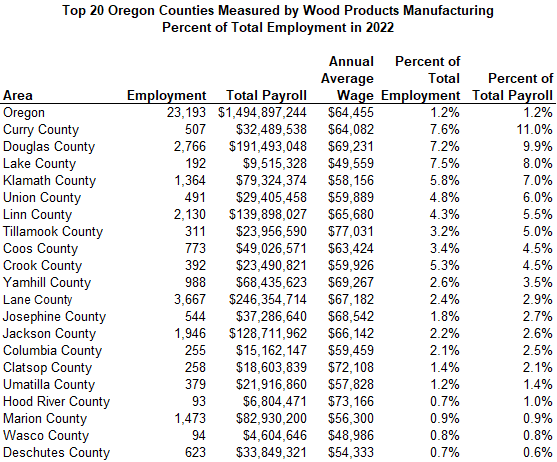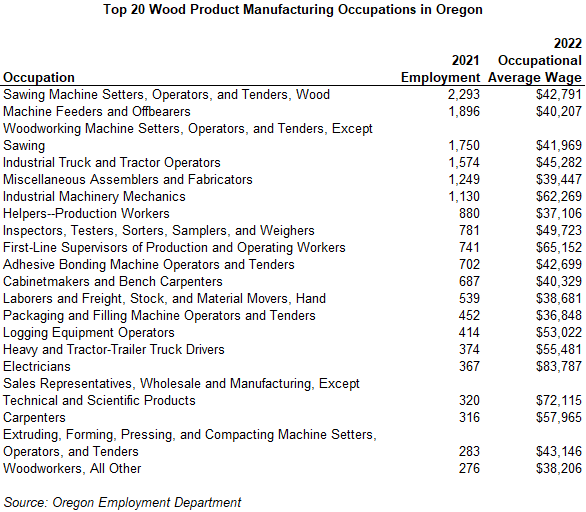Oregon’s Wood Product Manufacturing Industry Is Still Important, Especially in Rural Areas
April 26, 2023Once Oregon’s largest manufacturing industry, employment in the wood product manufacturing industry has gone through large, well-publicized losses since the early 1990s. Its employment dropped below that of computer and electronic manufacturing and food manufacturing in recent years. Despite the losses, wood product manufacturing is still a large industry in Oregon and is especially important to rural areas of the state.
Employment Trends
Over the long term, between 1990 and 2020, annual average employment in wood product manufacturing dropped 24,100, or 52%. Similar losses were experienced in all its subsectors. Sawmills and wood preservation dropped 5,900 (49%); plywood and engineered wood products dropped 9,500 (53%); and all other wood product manufacturing, which includes millwork and prefabricated buildings, dropped 8,700 (54%).

Although the industry has been in decline over the long term, it trended upward for a short period during a national housing boom between 2003 and 2005. During that period, the industry increased from an annual average of 31,100 jobs to 32,700, an increase of 1,600, or 5.1%.
Then the Great Recession hit the industry hard. The overall wood product manufacturing industry dropped 13,500 (41%) between 2005 and 2011. After the Great Recession, the industry was slow to rebound, adding 4,000 jobs, or 21%, between 2011 and 2019. Low demand from U.S. single-family home construction coming out of the recession is one reason for the slowness of the rebound. The prerecession peak of roughly 1.7 million starts in 2005 dropped to a low of 430,000 in 2011. Single-family starts had recovered to 888,000 in 2019, causing some increase in demand for wood products.
In 2020, employment in wood product manufacturing declined due to the COVID-19 pandemic and resulting restrictions, but not as much as some other industry sectors. The industry declined by 1,200 jobs or 5.2% on an annual average basis in 2020 compared with the 6.3% decline in total employment. Unlike the Great Recession, housing starts continued to grow during the COVID-19-induced recession, reaching 990,000 in 2020, helping to drive up lumber demand and prices. Annual average employment for wood product manufacturing in 2020 was 22,000. It had grown back to prepandemic levels at 23,400 by 2022.
Smaller Harvest, Technology, and Economies of Scale Contribute to Decline
Several structural shifts in the wood products industry have contributed to the long-term employment decline. First, there was a drop in timber harvests from environmental concerns in the early 1990s. As harvest from federal lands reduced the amount of available raw material to mills, employment dropped, indicating that harvest reductions were a cause for the employment loss in the early 1990s.

New technologies brought another structural change to the industry by making lumber mills less labor intensive. Employment continued to drop even after harvest levels stabilized in the late 1990s and employment did not increase much despite a housing construction boom in the mid-2000s. Jobs in wood product manufacturing per million board feet harvested dropped steadily after 2000, at least partly due to technology.
Lumber production per worker in Oregon is another way to look at efficiency gains. By combining Western Wood Products Association production data with sawmill employment data we can create a measure of lumber production per worker. It increased rapidly in the early 2000s, going from 806,000 board feet per worker in 2000 to 1.1 million in 2005. It then dropped back to 791,000 board feet during the Great Recession. It’s likely that mills cut production through fewer hours to some extent instead of letting go of workers during the recession. After the recession, production per worker increased to the elevated levels it had reached before the recession, reaching roughly 1.2 million board feet in 2017. Production per worker has stayed close to 1.2 million board feet per worker through 2021.
In addition to new technologies, smaller mills were shuttered, creating efficiency through economies of scale (larger mills can produce more per worker). The average production of sawmills operating in the western U.S. increased as smaller mills were shuttered and efficiency increased through economies of scale and new technology. Between 1990 and 2021, the number of mills in the western U.S. dropped from 600 to 144 while average production per mill increased from about 35 million board feet per year to 102 million board feet per year.

Wood Products Are Still Important in Oregon, Especially in Rural Areas
Even with the long-term decline, wood product manufacturing is still a large industry in Oregon. In 2022, there were 23,000 people employed and roughly $1.5 billion in total payroll in the industry. While statewide the industry makes up only 1.2% of total employment and 1.2% of total payroll, the concentration is much higher in some counties, especially rural ones. For instance, in Curry County 7.6% of total employment and 11.0% of total payroll was in wood product manufacturing. Most of the counties with a high concentration of employment in wood product manufacturing are rural.

In counties where the percent of total payroll exceeds the percent of total employment, average wages are higher in wood product manufacturing than the overall average wage. This is the case in most of the rural counties listed, indicating that wood product manufacturing provides some of the higher paying jobs in rural counties.
Jobs Generally Pay Well and Do Not Require High Levels of Education
The top 20 occupations in wood product manufacturing are mostly medium wage but do not require high levels of education. All of the top 20 occupations have a typical entry-level education of a high school diploma or less. Some of the more technical occupations like industrial machinery mechanics and electricians have average annual wages of more than $60,000 a year and have a typical entry-level education of a high school diploma, providing opportunity for those who don’t pursue a college degree.

Forecast
Employment projections from the Oregon Employment Department show that wood product manufacturing employment is expected to gain 1,000 jobs (4%) between 2021 and 2031.
Like many industries, wood product manufacturing has an aging workforce reaching retirement age. This creates demand for workers through replacement needs. Aside from gaining 1,000 jobs between 2021 and 2031, there are expected to be roughly 8,700 openings from people leaving the industry and the labor force, largely due to retirements.